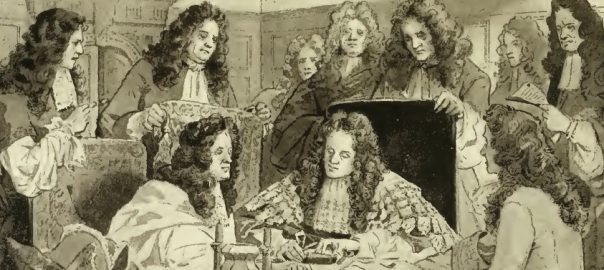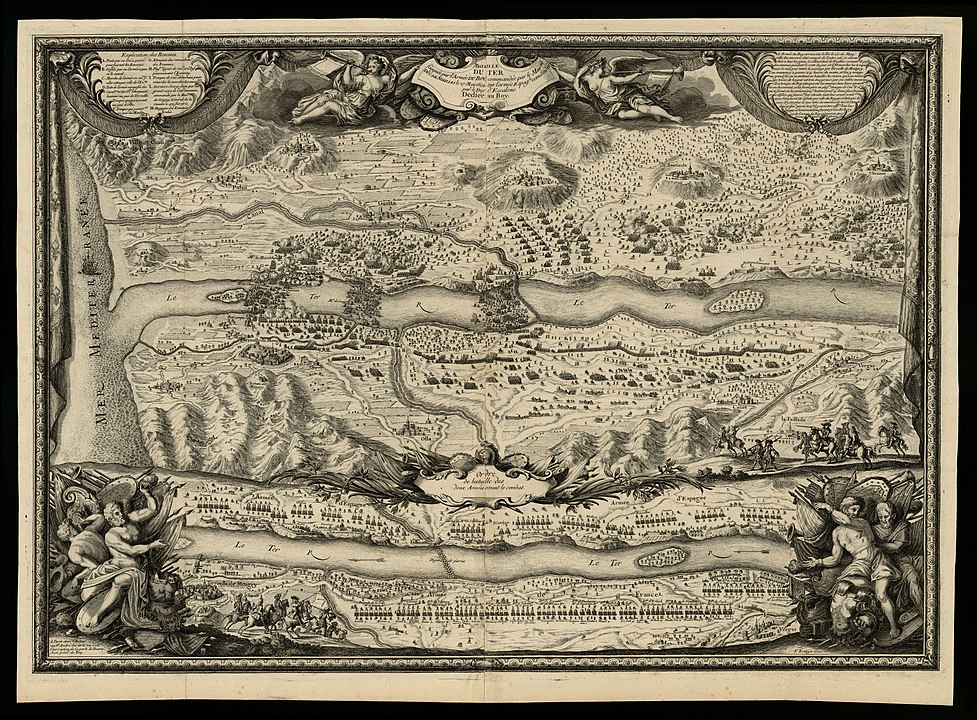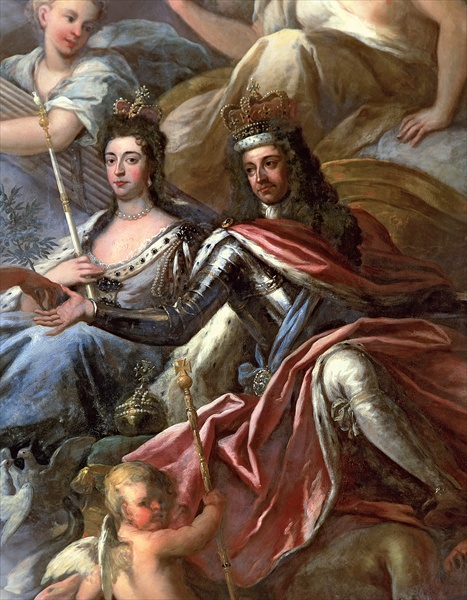There were several significant developments in 1694 CE. I shall look first at a couple of developments from southern Europe and the Mediterranean. Then we’ll go to England where 1694 saw the establishment of the Bank of England, the death of Queen Mary, and a couple other developments. Then we’ll go to Brazil, where the government finally suppressed the Qilombo dos Palmares, a significantly-sized community of people who had escaped slavery and of Indigenes and others, that had survived for nearly a century. Finally, we’ll look at the disturbing and detailed records that Thomas Phillips, an English slavetrading captain who worked for the Royal African Corporation, kept of how on a 1693-94 voyage he had bought, transported to Barbados, sold, and accounted for a “cargo” of 700 enslaved Africans.
News from southern Europe
This will be short. In February, 13 ships of the English Royal Navy were sunk by a storm in the Western Mediterranean. One of them was the ‘Royal Sussex’, which had possibly as much as ten tons of gold coins on board. Not clear what the money was to be used for.
In May of 1694, a French army of some 24,000 men fought and won a battle at Toroella in the Catalan interior against a similarly-sized Spanish Army.
News from England
On July 27, 1694, the Bank of England was established by a royal charter. This page on English-Wikipedia provides this vignette:
The Bank of England is the central bank of the United Kingdom and the model on which most modern central banks have been based. Established in 1694 to act as the English Government’s banker, and still one of the bankers for the Government of the United Kingdom, it is the world’s eighth-oldest bank [actually, tenth-oldest? see list here]. It was privately owned by stockholders from its foundation in 1694 until it was nationalised in 1946 by the Attlee ministry.
The founding of the bank was intimately tied to war and empire. WP explains:
England’s crushing defeat by France, the dominant naval power, in naval engagements culminating in the 1690 Battle of Beachy Head, became the catalyst for England to rebuild itself as a global power. William III’s government wanted to build a naval fleet that would rival that of France; however, the ability to construct this fleet was hampered both by a lack of available public funds and the low credit of the English government in London. This lack of credit made it impossible for the English government to borrow the £1,200,000 (at 8% per annum) that it wanted for the construction of the fleet.
To induce subscription to the loan, the subscribers were to be incorporated by the name of the Governor and Company of the Bank of England. The Bank was given exclusive possession of the government’s balances, and was the only limited-liability corporation allowed to issue bank notes. The lenders would give the government cash (bullion) and issue notes against the government bonds, which can be lent again. The £1.2 million was raised in 12 days; half of this was used to rebuild the navy.
As a side effect, the huge industrial effort needed, including establishing ironworks to make more nails and advances in agriculture feeding the quadrupled strength of the navy, started to transform the economy. This helped the new Kingdom of Great Britain – England and Scotland were formally united in 1707 – to become powerful. The power of the navy made Britain the dominant world power in the late 18th and early 19th centuries.
On December 28, Queen Mary II died unexpectedly at age 32. She had ruled jointly with her husband, King William III, and she never had a child.
During much of the six-year period since they had been crowned following what their supporters called the “Glorious Revolution” in England, William had been out of England, fighting various wars, both against the king he had deposed, James II, who was Mary’s father, and against the French. In his absence, Mary had ruled over things at home in a way generally judged to have been capable.
This page on WP tells us:
[S]he proved a firm ruler, ordering the arrest of her own uncle, Henry Hyde, 2nd Earl of Clarendon, for plotting to restore James II to the throne. In January 1692, the influential John Churchill, 1st Earl of Marlborough, was dismissed on similar charges; the dismissal somewhat diminished her popularity and further harmed her relationship with her sister Anne (who was strongly influenced by Churchill’s wife, Sarah). Anne appeared at court with Sarah, obviously supporting the disgraced Churchill, which led to Mary angrily demanding that Anne dismiss Sarah and vacate her lodgings.
… [In April 1692, Mary] failed to visit Anne, who was suffering a difficult labour. After Mary’s recovery and the death of Anne’s baby soon after it was born, Mary did visit her sister, but chose the opportunity to berate Anne for her friendship with Sarah. The sisters never saw each other again. Marlborough was arrested and imprisoned, but then released after his accuser was revealed to be an impostor. Mary recorded in her journal that the breach between the sisters was a punishment from God for the “irregularity” of the Revolution. She was extremely devout, and attended prayers at least twice a day.
So in December 1689, Parliament had passed the Bill of Rights. In addition to codifying many of the fundamental rights of England’s people and parliament, the Bill of Rights also laid out clear rules for the post-James succession. William and Mary were reigning jointly, and–
Following the death of either William III or Mary II, the other was to continue to reign. Next in the line of succession would be any children of the couple, to be followed by Mary’s sister Anne and her children. Last in the line of succession stood any children William III might have had from any subsequent marriage.
These succession rules were indeed respected over the years that followed. But meantime, for another couple of decades after 1694, English politics was mired in a period of political instability called the “Rage of Party.” That instability had little effect on the continuing operations of empire and the military-industrial complex that ran it.
The banner image at the top is a detail from an illustration of the founding of the Bank of England.
Brazil destroys Quilombo dos Palmares
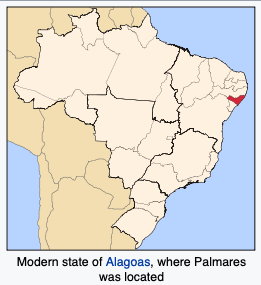
The Quilombo dos Palmares, was a community of people in colonial Brazil who had escaped from slavery on coastal plantations, that had developed from 1605 on. By the 1690s, the numbers of people living in it had risen to between 11,000 and 20,000. English-WP tells us that Yale historian Stuart Schwartz noted that it was “undoubtedly the largest fugitive community to have existed in Brazil”.
WP adds:
Palmares was the general name given by the Portuguese in Pernambuco and Alagoas to the interior districts beyond the settlements on the coast, especially the mountain ranges, because there were many palm trees there. As early as 1602, Portuguese settlers complained to the government that their captives were running away into this inaccessible region and building mocambos, or small communities. However, the Portuguese were unable to dislodge these communities, which were probably small and scattered, and so expeditions continued periodically into the interior.
During this time the vast majority of the enslaved Africans who were brought to Pernambuco were from Portuguese Angola, perhaps as many as 90%, and therefore it is no surprise that tradition, reported as early as 1671, related that its first founders were Angolan.
The inhabitants of the Quilombo, WP tells us,
developed a society and government that derived from a range of Central African sociopolitical models, a reflection of the diverse ethnic origins of its inhabitants, although Schwartz emphasizes that the residents of Palmares “combined these [sociopolitical models] with aspects of European culture and specifically local adaptations.” This government was confederate in nature, and was led by an elected chief who allocated landholdings, appointed officials (usually family members), and resided in a type of fortification called Macoco.
Does this start to sound familiar? Yes, we had heard about the Quilombo dos Palmares before, in 1678, when Ganga Zumba was its king. But the Quilombo dos Palmares page on WP gives us more details of how it was organized:
By the 1640s, many of the mocambos had consolidated into larger entities ruled by kings. Dutch descriptions by Caspar Barlaeus (published 1647) and Johan Nieuhof (published 1682) spoke of two larger consolidated entities, “Great Palmares” and “Little Palmares”. In each of these units there was a large central town that was fortified and held 5,000-6,000 people. The surrounding hills and valleys were filled with many more mocambos of 50 to 100 people. A description of the visit of Johan Blaer to one of the larger mocambos in 1645 (which had been abandoned) revealed that there were 220 buildings in the community, a church, four smithies, and a council house. Churches were common in Palmares partly because Angolans were frequently Christianized, either from the Portuguese colony or from the Kingdom of Kongo, which was a Christianized country at that time. Others had been converted to Christianity while enslaved. According to the Dutch, they used a local person who knew something of the church as a priest, though they did not think he practiced the religion in its usual form. Schwartz notes that African religious practices were also preserved and suggests that the depiction of Palmares as a largely Christian settlement is perhaps reflective of confusion or bias on the part of contemporary commentators.
Okay, I’m just going into this level of detail because it is agonizing to think how that experiment ended:
After a particularly devastating attack by the [Brazilian] captain Fernão Carrilho in 1676-7 that wounded Zumba and led to the capture of some of his children and grandchildren, Ganga Zumba sent a letter to the Governor of Pernambuco asking for peace. The governor responded by agreeing to pardon Gana Zumba and all his followers, on condition that they move to a position closer to the Portuguese settlements and return all enslaved Africans that had not been born in Palmares. Although Gana Zumba agreed to the terms, one of his more powerful leaders, Zumbi refused to accept the terms…
In a short time, Zumbi had organized a rebellion against Ganga Zumba, who was styled as his uncle, and poisoned him (though this is not proven, and many believe Zumba poisoned himself as a warning not to trust the Portuguese). It is argued that Zumba was sick of fighting, but even more wary of signing the deal with the Portuguese, foreseeing their betrayal, and renewed war. By 1679 the Portuguese were again sending military expeditions against Zumbi. Meanwhile, the sugar planters reneged on the agreement and re-enslaved many of Gana Zumba’s followers who had moved closer to the coast.
From 1680 to 1694, the Portuguese and Zumbi, now the new king of Angola Janga, waged an almost constant war of greater or lesser violence. The Portuguese government finally brought in the famed Portuguese military commanders Domingos Jorge Velho and Bernardo Vieira de Melo, who had made their reputation fighting indigenous peoples in São Paulo and then in the São Francisco valley. These men enlisted existing Pernambuco forces and local indigenous allies, who proved instrumental in the campaign. The final assault against Palmares occurred in January 1694. Cerca do Macaco, the main settlement, fell; accounts suggest a bitter fight that saw 200 inhabitants of Palmares kill themselves rather than surrender and face re-enslavement. Zumbi was wounded. He eluded the Portuguese, but was betrayed, finally captured, and beheaded on November 20, 1695…
Although the kingdom was destroyed the Palmares region continued to host many smaller runaway settlements, but there was no longer the centralized state in the mountains.
English slave-trader takes detailed notes for a ‘How-to’ manual
In 1693, a 29-year-old Welsh sea-captain called Thomas Phillips got a contract from a Royal African Corporation (RAC) director to undertake a “triangular” voyage in a 450-ton ship called ‘Hannibal’, that had 36 guns. The voyage would take him from London to Ouida in West Africa, then to Barbados, and home. He bought the necessary trade-goods from London, then set out in September, arriving in Ouida in early 1694. As Phillips undertook this voyage, which may have been his first (and was certainly his last, as he fell sick toward the end of it), he clearly took detailed notes of numerous aspects of his work including such tasks as:
- Outfitting the ship
- Navigating it
- Dealing with the crew members
- Dealing with the African community leaders he encountered in Ouida
- Trading with those leaders for various supplies
- Purchasing 700 enslaved people from the leaders in Ouida
- Handling and controlling the enslaved on shore, and then on board ship
- Selling them in Barbados.
Phillips’s account of this voyage seems to have first been published in 1732. It is unclear whether he first produced it as an aide-memoire for himself, to help him on future slaving voyages; or as a detailed former report that the RAC could use for instructions for any future captain; or as something he might publish and make some money from. It seems to have had aspects of all three goals. The full text of the 69-page version published in 1732 can now be viewed or downloaded from here.
There are modernized transcriptions of the report that one can find online, e.g., here, and read. But I thought it would be good to dive into a version as close to the original as possible.
I found it to be very disturbing reading, so be warned that you might, too.
‘How to buy and profitably ship enslaved people’, by T. Phillips
Phillips and a rival slaving-ship captain were both in Ouida at the same time. He had spent several weeks getting to know the local society, and wrote about it in great detail. Then he and his rival got to business, deciding to divide the task between them rather than compete against each other. One went to the “trunk” to do the buying one day, and the other next. The chief interlocutor they were dealing with on the African side, they called the “king”, and his principal attendants were called “cappasheirs”.
Here’s how Phillips bought his “slaves”, starting in May 1694 (p.218):

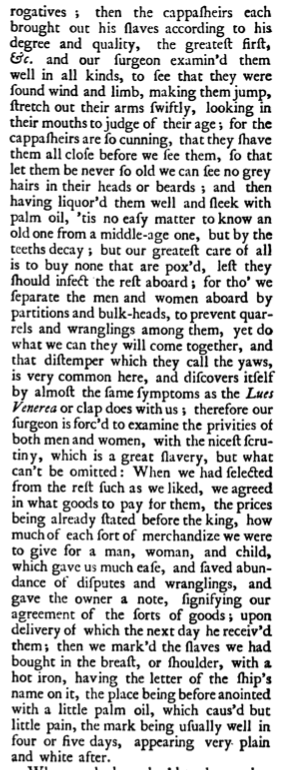
Here were some steps he took in his attempt to control them (and how desperate some of them were to escape), from p.219:
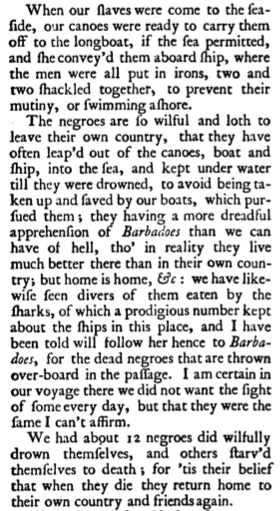
And some more about control mechanisms, from p.229:
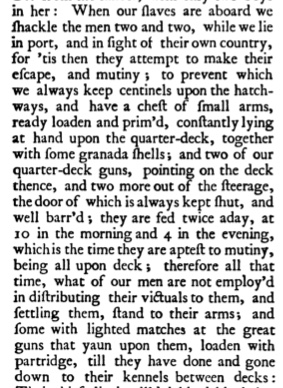
Also, this, from 229-30:

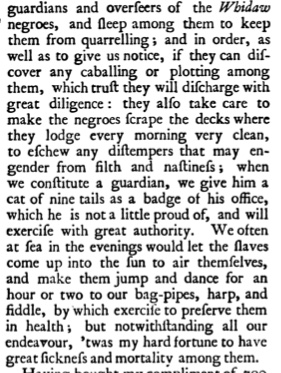
Purchasing the enslaved seemed to take a few weeks. Then in late July, he was done. This, also from p.230:
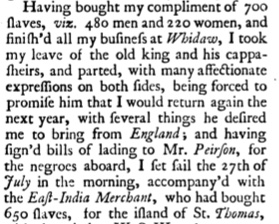
In August, he arrives at Sao Tome, a good place for re-victualling, though he was wary of the Portuguese people there. He finished his business there in about two weeks, and reported that he could not stay longer “in respect of the mortality of my negroes, of which two or three died each day, also the small quantity of provisions I had to serve for my passage to Barbados” (p.234.)
In November, they reached Barbados, and there was this notation (p.236):
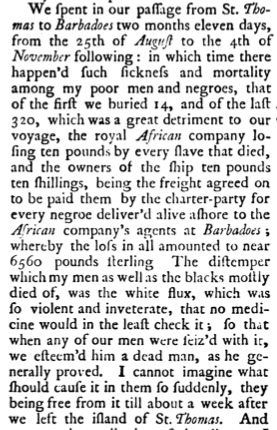
He wrote quite a lot about the diseases that afflicted his “men” and his “negroes”– these two being, for him, quite distinct categories. He noted that the “negroes” seems to be able to recover from smallpox but died from a generally unidentified “flux”, that is diarrhea, which he found “noisome” to deal with. Plus, every “negroe” who died reduced the RAC’s profits, and his own too, since as part-owner of the ship he would be paid freightage only for those enslaved persons who arrived safely and could be sold in Barbados. At p. 237 he writes this:
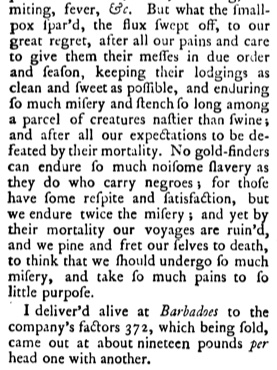
There are obviously numerous observations one can (and should!) make based on just these small excerpts from Phillips’s report. I just want to sit with this disturbing text a bit longer before commenting.
